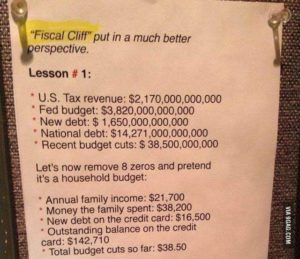Many recent media headlines have given us deja vu – the resurgence of “Bennifer,” a Space Jam movie in theaters, billionaires funding space travel, and concerned talking heads chattering about the steadily rising national debt.
The United States debt ceiling has been suspended through the end of July, meaning that there is no limit on the amount of money the federal government can borrow. Believe it or not, 2021 is zipping by (funny how time moves faster when you’re able to leave the house!) and the month is almost over. With the expiration of the suspension on the horizon, politicians are advocating for an extension of the suspension, among other more long-term suggestions such as increasing the debt ceiling.
Just like Ben and JLo’s titillating romance, an increase in our nation’s debt is nothing new (although it is much less exciting). However, the events of 2020 and COVID relief payments have driven the debt up at a faster rate, and as of April 2021 the US national debt was $28.1 trillion.
Measuring National Debt
While many headlines deliver news about the national debt in this dollar-amount format, it’s usually measured as a percentage of our GDP, or gross domestic product. GDP is an indicator used to track the health of a nation’s economy, and represents the total dollar value of all the goods and services produced by that economy over a specific time period.
This figure includes personal consumption (how much each citizen earns / spends in a year), private investments, government spending, and exports (minus imports). The GDP is important because it is often used by bankers to set target interest rates. Some investors will use it to predict market trends (their line of thinking: low GDP means a bad economy which means lower stock prices).
The US Government is not held to the same standards as publicly traded companies when it comes to presenting its finances, meaning that the government does not have to account for explicit and implicit future obligations. This means that the actual GDP and national debt are often actually a little bit worse than what the government reports. If you’re surprised, you shouldn’t be, since Sean revealed a similar trend in reported economic factors versus the cold, hard reality of the situation when he discussed inflation.
GDP & the US National Debt
The United States is projected to record a government debt equivalent to 107% of our Gross Domestic Product by the end of the year. The Congressional Budget Office predicts that the federal government could run a deficit every year for the next 3 decades, with debt reaching 147% of the GDP by 2049. This is a global trend, extending to other economies outside the US as well.
Let’s compare this to a household income. A lot of people try to overcomplicate the idea of national debt, but on a basic level it’s just like personal debt: if you spend more than you make, then you go into debt. If your household finances were functioning the same way as the US’ this year, you would have incurred a little more debt than what you make all year – and that’s on top of your regular expenses.

That seems bad…
If my personal finances mimicked the United State’s economy’s current debt situation, I’d definitely be sweating a little bit. But to say that operating with debt is the norm for the US is an understatement. You may find some comfort in knowing that the US has not been debt-free since 1835, when President Andrew Jackson paid off the $75 million US debt by selling land in the western part of the US and blocking all spending bills. This debt-free moment in the United States’ history lasted one whopping year. So the United States is pretty used to this.
The bailouts of 2010 and the COVID pandemic relief efforts caused a significant spike in our debt recently, but the US has operated in some sort of deficit for 55 of the last 60 years:
- $381 billion in 1970;
- $909 billion in 1980;
- $3.2 trillion in 1990;
- $5.6 trillion in 2000;
- $13.5 trillion in 2010; and
- $23 trillion in 2020
So… it’s fine, then?
A lot of people assume that high national debt is a precursor to a huge economic disaster, but the reality is that high debt actually follows economic and financial disasters rather than precedes them. The real concern is not that high national debt will cause another disaster but that it puts the economy in a more vulnerable position for the next economic disaster (such as COVID).
Private sector debt, which is the debt held by households and privately owned companies rather than the government, is actually more concerning than the national debt when it comes to omens for financial disasters.
Just like with a personal household’s debt, the amount that a business owes is less concerning than their ability to pay it off. Driven by historically low interest rates, private corporations have accumulated very large amounts of debt in the last few years, especially in the form of corporate bonds.
Soon, interest rates will rise which could trigger a wave of selling, and too many sellers with too few buyers could create a debt-related financial crisis. Classic methods of creating a resilient portfolio such as diversifying holdings is not necessarily going to be an effective strategy in this kind of market behavior, but Sean and our NEST team has years of experience and relies on data received weekly to anticipate and plan for these kinds of things so that we can pivot if it becomes necessary. Reach out today if you’d like to discuss that further.
Do your best not to let the national debt stress you out, but if the headlines get overwhelming, close the laptop and take three slow, deep breaths and imagine you’re with Ben and Jen on a yacht in Maui. Because if Bennifer has taught us one thing, it’s that hope springs eternal.
DISCLAIMER: We are legally obligated to remind you that the information and opinions shared in this article are for educational purposes only and are not financial planning or investment advice. For guidance about your unique goals, drop us a line at info@nestfinancial.net.
Find us on:






[…] about the debt ceiling have dominated the news cycle since August, when the suspension enacted in 2019 expired and the debt ceiling was reinstated at $28.5 trillion […]
[…] intriguing undercurrents of US economics. We’re about to navigate the tumultuous seas of the US debt ceiling, a subject notorious for inciting congressional showdowns and driving budget debates. So, […]